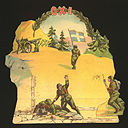
 |
Greece No! The existence of rival Communist and national-conservative resistance groups which had already clashed with each other during the War led to a civil war in Greece after the end of World War II. The deep division in society had to be overcome. The resistance during the Second World War was evoked as a struggle of the entire nation. Nothing was said about the division between the Left and the Right even during the political and cultural spring in the early 1960s, and it remained so during the period of the Junta, which ruled Greece from 1967 to 1974. The subsequent restoration of democracy was accompanied by a radical politicization, especially of the youth. Both the parliamentary and the extra-parliamentary Left became predominant. Their emphasis on the heroic aspects of the resistance prevailed in the remembrance of the War and the time of the German occupation. A further turning point came in 1982 when the governing party officially recognized the leftist resistance movement. This finally allowed the Communist fighters to openly recognize their participation in the resistance during the World War. This reconciliation of the divided memories also helped to overcome the consequences of the civil war. |
| Even in present-day Greece the end of the Second World War is not commemorated. Instead they celebrate the 28 th of October 1940. This is the day on which Prime Minister Metaxas curtly dismissed Italy's ultimatum to occupy Greek territories. The Greek army was able to repel the subsequent assault of the Italians. So the 28th of October stands symbolically for Metaxas' "Oxi!" (No!) with which the Greeks confronted their invaders in 1940. In the collective memory this day is considered proof of the invincibility of the Greek army and the solidarity of the nation. On the day before the national holiday a celebration is held in all of the schools. The walls are decorated with slogans such as "No", "Long live the Nation" and "Long live the 28th of October 1940". This "No" is also a popular motif for toys such as this little paper setting. It shows a mountainous area with soldiers who are defending Greece. Atop the scene is the word "Oxi", like a vow crowned in laurel. These celebrations have been carried out in this very same way since 1945. The "No" is the only symbol of resistance which both Left and Right were mutually able to commemorate. |
|
| When democracy was restored, the leftist resistance was able to raise its voice again. Spyros Meletzēs could finally publish his portfolio of photographs of the armed resistance against the occupation. Meletzēs had already made enlargements of the photographs in 1947 for an exhibition, which could not be realized due to the civil war, however. His photo book "With the Partisans in the Mountains" appeared in 1986. The most famous photograph of the series, "Daskalos-Antartēs" (Teacher Partisan), is on the cover. | |





